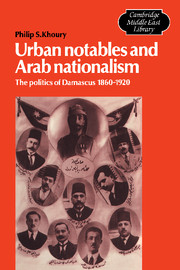Book contents
- Frontmatter
- Contents
- List of maps
- Note on transcription
- Preface
- Introduction
- 1 The political configuration of Damascus in 1860
- 2 The consolidation of leadership in Damascus after 1860
- 3 Damascus notables and the rise of Arab nationalism before World War I
- 4 Notables, nationalists and Faysal's Arab government in Damascus, 1918–20
- Conclusion
- Notes
- Bibliography
- Glossary of Arabic, Persian and Turkish terms
- Index
- Frontmatter
- Contents
- List of maps
- Note on transcription
- Preface
- Introduction
- 1 The political configuration of Damascus in 1860
- 2 The consolidation of leadership in Damascus after 1860
- 3 Damascus notables and the rise of Arab nationalism before World War I
- 4 Notables, nationalists and Faysal's Arab government in Damascus, 1918–20
- Conclusion
- Notes
- Bibliography
- Glossary of Arabic, Persian and Turkish terms
- Index
Summary
No idea has captured the imagination or expressed the hopes of the Arabs in the twentieth century as has Arab nationalism, and perhaps no subject has received so much attention from historians of the Middle East. But while many historians have explored its sources, few have considered the social and political environment in which Arab nationalism evolved as an ideological movement. This study attempts to correct the imbalance.
Its focus is on the social and political life in Ottoman Damascus and, in particular, on the great notable families of that city who were to play a disproportionate role in politically activating the Arab nationalist idea before World War I. Chapters 1 and 2 explore the ways such long-term factors as the Ottoman reformation, European economic expansion and agrarian commercialization in Syria encouraged rival and socially differentiated networks of locally influential families in Damascus to merge into a socially cohesive upper class. Under the umbrella of a reinvigorated Ottoman central authority, this class of landowners and bureaucrats produced a new urban leadership which dominated local politics after 1860.
Although this leadership faced no serious challenges from further down the social scale in Damascus, it was by no means free of internal conflicts. Economic and political competition between and within upperclass family networks was always rife. Chapter 3 focuses on the ways this factionalism comes to be expressed in ideological terms, after the Young Turk revolution of 1908 shook the established balance of power between the Arab provincial elites and the Turkish authorities.
- Type
- Chapter
- Information
- Urban Notables and Arab NationalismThe Politics of Damascus 1860–1920, pp. ix - xiiPublisher: Cambridge University PressPrint publication year: 1983

